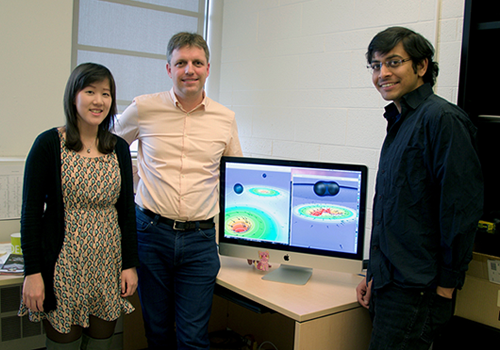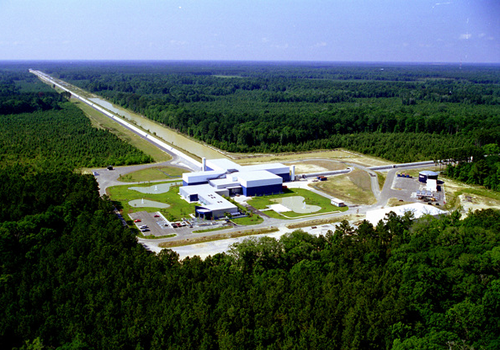For the first time, the team at the Laser Interferometer Gravitational Observatory (LIGO) detectors has observed gravitational waves — ripples in the fabric of spacetime coming from a cataclysmic event in the distant universe, likely the collision of black holes. The discovery promises to open a new window into the cosmos.

U of T role instrumental
The discovery was made by the LIGO Scientific Collaboration, a group of more than 1,000 scientists from universities in the United States and 14 other countries. A team of astrophysicists at the University of Toronto played an instrumental role in providing some of the calculations that enabled a successful search.
For Associate Professor Harald Pfeiffer, U of T’s lead on the collaboration, the announcement is doubly exciting. “It is absolutely stunning to see two ground-breaking discoveries at once,” said Pfeiffer, a scientist at the Canadian Institute for Theoretical Astrophysics (CITA) at the University of Toronto, a fellow at the Canadian Institute for Advanced Research (CIFAR) and holder of the Canada Research Chair for Numerical Relativity and Gravitational Wave Astrophysics.
“Not only were gravitational waves measured for the very first time passing through Earth, but these waves were caused by astronomical objects that have never been observed before.”
Black holes exist and collide!
“We see today that black holes exist in the universe and they do collide!” said Pfeiffer.
The gravitational waves were detected on September 14, 2015 by the twin Laser Interferometer Gravitational-wave Observatory (LIGO) detectors, located in Livingston, Louisiana and Hanford, Washington, USA. The breakthrough has been accepted for publication in Physical Review Letters.
Gravitational waves carry information about their dramatic origins and about the nature of gravity that cannot otherwise be obtained.
The detected waves were produced during the merger of two black holes that occurred more than a billion years ago, creating a single, massive spinning black hole. This collision of two black holes had been predicted but never observed.
Based on the observed signals, LIGO scientists estimate that the black holes for this event were about 29 and 36 times the mass of the sun, and the event took place 1.3 billion years ago. By looking at the time of arrival of the signals — the detector in Louisiana recorded the event seven milliseconds before the detector in Washington — scientists can say that the source was located in the Southern Hemisphere.
In addition to Pfeiffer, U of T team members include postdoctoral fellow Prayush Kumar and PhD candidate Heather Fong, both at CITA. Former CITA Senior Research Associate Kipp Cannon had led the group since it’s inception in 2010, before departing just weeks ago for Tokyo University.
Cannon spearheaded the development and operation of one of the search strategies that identified the gravitational wave in the detector data.
Discovery beyond “wildest dreams”
“This detection is beyond our wildest dreams,” Cannon said. “This signal is so loud that we can see clearly the bending of spacetime by colliding black holes imprinted in the waveform. It’s hard to exaggerate how much these few seconds of data have advanced our understanding of nature.”

The LIGO Laboratory operates two detector sites, one near Hanford in eastern Washington, and another near Livingston, Louisiana. This photo shows the Livingston detector site. Photo courtesy of the LIGO Scientific Collaboration.
Pfeiffer’s contributions to the LIGO project are informed by his work as the head of the Numerical Relativity group at CITA. The group is among the world’s leaders in simulating collisions of black holes on high-performance supercomputers. Their calculations produced the gravitational waveforms — the shapes of the signals — that LIGO searches for.
The results rely in part on the calculations performed on Canadian supercomputers, including U of T’s SciNet. The SciNet systems have been instrumental during the past years for calculations of binary black hole mergers. These calculations enabled scientists to cross-check and verify some of LIGO’s results reported today.
“I started graduate school at U of T because I wanted to study gravitational waves, and CITA is currently the only research facility in Canada involved in this exciting field,” said Fong, who, together with Kumar, contributed to and validated the waveforms.
According to general relativity, a pair of black holes orbiting around each other lose energy through the emission of gravitational waves, causing them to gradually approach each other over billions of years, and then much more quickly in the final minutes.
During the final fraction of a second, the two black holes collide into each other at nearly one-half the speed of light and form a single more massive black hole, converting a portion of the combined black holes’ mass to energy, according to Einstein’s formula E=mc2. This energy is emitted as a final strong burst of gravitational waves. It is these gravitational waves that LIGO has observed.
“This first observation of gravitational waves by LIGO is as exciting as the first look through telescopes was to the earliest astronomers,” Kumar said.
Support for the CITA members’ contributions to the research comes from CIFAR, the Canada Research Chairs Program, the Natural Sciences and Engineering Research Council of Canada, the Province of Ontario and the University of Toronto.
Videos:
Computer simulation of gravitational waves up close
Advanced LIGO saw gravitational waves from two black holes that merged over a billion light years from Earth. This computer simulation shows (in slow motion) what this would look like up close. If this movie were played back in real time, it would last for about one third of a second. READ MORE
What is a gravitational wave?
LIGO - What is a Gravitational Wave? from Kai Staats on Vimeo.
Watch all the videos on the LIGO Scientific Collaboration website to learn about what gravitational waves are, how they are detected and where they come from. READ MORE

